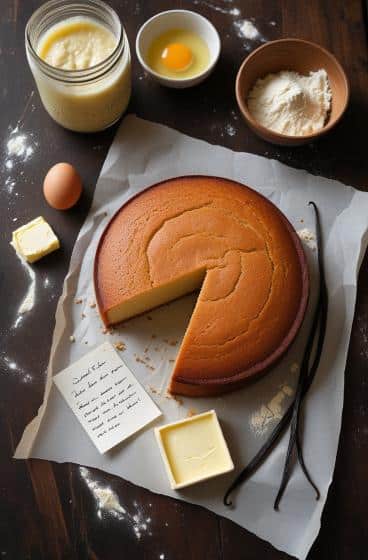If you’ve never baked a cake with sourdough starter, you’re about to fall into a kind of wild, tangy-sweet love affair. You’ll swear you’re just using up extra discard, but what comes outta that oven? It’s soft like clouds, golden around the edges, a little bit chewy in the crumb—but only just enough to remind you there’s life inside it. Real life.
Now, I didn’t expect to like sourdough vanilla cake the first time I made it. I was elbow-deep in discard, thinking only of pancakes and maybe a reluctant flatbread or two. But then I thought—why not cake? Why not let the fermentation do a bit of work in dessert too? Turns out, the answer was why not cake. Why had I waited this long?
This isn’t just vanilla cake with a fancy starter tossed in. The sourdough changes the structure. It deepens the flavor. It tames the sweetness so the vanilla comes through full-bodied and honest. Not perfumey. Not fake. Just warm and lush and softly tangy—like how a Sunday morning ought to taste.
What Is a Sourdough Vanilla Cake?
Sourdough vanilla cake is exactly what it sounds like: a simple, plush vanilla cake enriched with active or discard sourdough starter. But what it really is? It’s fermentation’s quiet handshake with dessert.
This cake carries the unmistakable tenderness of a fermented crumb. You’ll notice the flavor first—it leans deeper than a regular yellow cake. Not sharp like lemon, not sour like yogurt. Just mellow. Like something that sat and thought about its life before being baked.
It’s also got longevity. The starter not only helps with rise and texture but makes the cake stay soft and moist for days. The crust browns up beautifully. And if you let the batter sit overnight before baking—boom—you get this almost brioche-like complexity.
And here’s the kicker: you can make it with active starter or that tired discard you were gonna toss. Waste not, want cake.
Ingredients & Substitutions
Your ingredient list here’s classic but with room for play. Don’t go messing with the starter though—it’s the star.
| Ingredient | Quantity | Substitutions / Notes |
|---|---|---|
| All-purpose flour | 2 cups | Can use cake flour for a more delicate crumb (reduce by 2 tbsp per cup) |
| Baking powder | 2 tsp | Don’t skip. Sourdough helps rise but not alone. |
| Baking soda | ½ tsp | Needed for balancing the acidity from sourdough |
| Salt | ½ tsp | Sea salt works beautifully here |
| Granulated sugar | 1¼ cups | Cane sugar or coconut sugar okay; brown sugar will deepen molasses flavor |
| Unsalted butter (softened) | ½ cup | Can sub with neutral oil, but butter gives more flavor |
| Eggs | 2 large | Room temp. For vegan, try flax eggs + 1 tbsp extra oil |
| Sourdough starter (100%) | 1 cup | Discard or active both work, just not too cold or inactive |
| Whole milk | ½ cup | Almond or oat milk works. Avoid low-fat—won’t be creamy enough |
| Greek yogurt | ¼ cup | Adds tang and tenderness. Sub with sour cream if needed |
| Vanilla extract | 1 tbsp | Go pure. Don’t use artificial unless you want sadness in cake form |
Notes on Ingredient Quality
Don’t underestimate the vanilla. If you’re gonna spend hours coaxing a tangy flavor out of starter, don’t kill it with cheap vanilla. Go real, or go with paste if you’re feeling luxe.
Use room temp eggs and butter—non-negotiable. Cold ingredients break emulsions and ruin the batter texture.
If your discard’s been chilling for weeks in the fridge? Maybe not the best idea. Use it if it’s still bubbly-smelling and not gray or funky. You want “pleasantly tangy,” not “gym sock.”
Step-by-Step Instructions
Step 1: Cream Your Butter and Sugar
You want it fluffy. Not just mixed—fluffed. Like a good pillow.
Beat softened butter and sugar on medium-high for a full 3-4 minutes. It should look like frosting before you move on. Skipping this means your cake will be dense. Sad. We’re not doing sad today.
Step 2: Add Eggs, One at a Time
Crack ‘em in slow. Beat after each addition until fully combined. If it looks a bit curdled? Don’t panic. The starter’s gonna fix that later.
Add your vanilla here too. Let the scent tell you when it’s ready.
Step 3: Stir in the Sourdough Starter
Mix it in gently. You don’t want to deflate all that fluffy fat you just creamed. It’ll look a little loose. That’s okay.
If your starter was cold, the batter might seize a bit—let it sit for 10 mins to come to temp.
Step 4: Combine Dry Ingredients
Whisk together flour, baking powder, baking soda, and salt in a separate bowl.
Always whisk dry separately. I don’t care how many cakes you’ve made. Lumps in flour lead to tunneling.
Step 5: Alternate Adding Dry and Wet
Now add the dry mixture to your wet in thirds, alternating with milk and yogurt. Start and end with dry.
Mix until just combined. Don’t overbeat unless you like rubbery cake.
Step 6: Rest (Optional but Glorious)
Here’s where things get interesting. You can bake this right away. But if you cover and rest it overnight in the fridge?
The sourdough gets to stretch its legs. You’ll get more depth, tighter crumb, and slightly chewier edges. Like a cross between a birthday cake and a sweet focaccia.
Step 7: Bake
Pour into a greased and floured 9-inch round or 8×8 square pan.
Bake at 350°F (175°C) for 35–40 minutes. Check with a toothpick at 30—it should come out with a few crumbs. Not wet. Not dry. Crumby.
Let it cool in the pan 10 mins, then transfer to wire rack. Don’t rush or it’ll crack in the middle. Be patient. Let it settle into itself.
Cooking Techniques & Science
Why Sourdough in Cake?
Fermentation doesn’t just make things rise. It breaks down gluten strands, making them easier to digest. It also pre-acidifies your batter, so you get a tighter crumb and natural shelf-life extension.
Sourdough also adds complex flavor compounds. Think malty, nutty, slightly savory tones—like the background notes in good honey.
Using discard introduces acidity and subtle wild yeast tones. An active starter gives more rise, but not necessary if you’re using baking soda + powder.
Why Resting Matters
Letting your batter rest overnight allows the flour to hydrate fully. The fermentation also continues slowly in the fridge, giving deeper flavor and a more elastic structure.
It’s like the difference between a no-knead overnight bread and a same-day loaf. Both are fine. One is unforgettable.
Storage & Reheating
This cake keeps moist for 3–4 days, wrapped at room temp.
Store in an airtight container. Avoid the fridge unless you’re in a super hot climate—it’ll dry out.
To reheat? Microwave a slice for 10 seconds. Add a pat of butter if you’re feeling scandalous.
You can also freeze the whole cake (or slices). Wrap tightly in plastic, then foil. Thaws beautifully in the fridge overnight.
Variations & Substitutions
Vegan: Use flax eggs + plant-based yogurt and milk. Replace butter with coconut oil or vegan butter.
Gluten-free: Use a 1:1 GF flour blend, but let it rest at least 12 hours before baking. Helps prevent gumminess.
Spiced: Add a pinch of cardamom and cinnamon. Sourdough + spice = magic.
Citrus twist: Add lemon zest and juice. Pair with a lemon glaze. Unreal.
Serving & Pairing Suggestions
You can serve it plain. You shouldn’t, but you could.
Dress it up with whipped cream, a drizzle of honey, or even a thin lemon glaze. Toasted almonds? Yes. Fresh berries? Even better.
For drinks, try:
- Earl Grey tea (the bergamot plays nice with sourdough)
- Cold brew coffee
- A glass of oat milk if you’re keeping things cozy
It also plays nice next to fruit compotes, roasted peaches, or even a splash of amaretto if you’re feeling fancy.
Best Time to Serve or Eat
Brunch. Period.
This cake was born for a brunch table next to quiche and fruit salad and slightly wilted tulips in a mason jar.
But also? Midnight.
When your brain says “toast” but your soul whispers “cake.” That’s when sourdough vanilla cake slides in like a soft lullaby.
Conclusion
Sourdough vanilla cake is what happens when fermentation humbles dessert. It’s not flashy. It doesn’t shout. But it lingers.
It’s a cake with backbone. With patience. With character. It uses what you’ve already got—discard, butter, flour—and turns it into something soft and golden and shockingly rich.
Don’t overthink it. Don’t underbake it. Just try it. Once you do, boxed cake mix will taste like regret.
Whether you go classic or tinker with lemon or cardamom or maple, the sourdough will keep it grounded. Honest. Alive.
FAQs
1. Can I use sourdough discard straight from the fridge?
Yes, but let it come to room temperature first. Cold starter can mess with your batter texture.
2. Does it taste sour?
Not exactly. It tastes rounded. Tangy in the way yogurt is. It balances the sweet, not battles it.
3. Can I make cupcakes instead of cake?
Yep. Bake at 350°F for 18–22 minutes. Check early—they cook faster.
4. Is this cake good for layering?
Surprisingly, yes. It’s sturdy enough for frosting but soft enough to stay moist. Just cool fully before slicing.
5. Can I frost it? What kind works best?
Oh, you should frost it. Cream cheese or vanilla buttercream are both dreamy. Whipped ganache if you’re dramatic (like me).
Let it be simple. Let it be bold. Just let it ferment.

